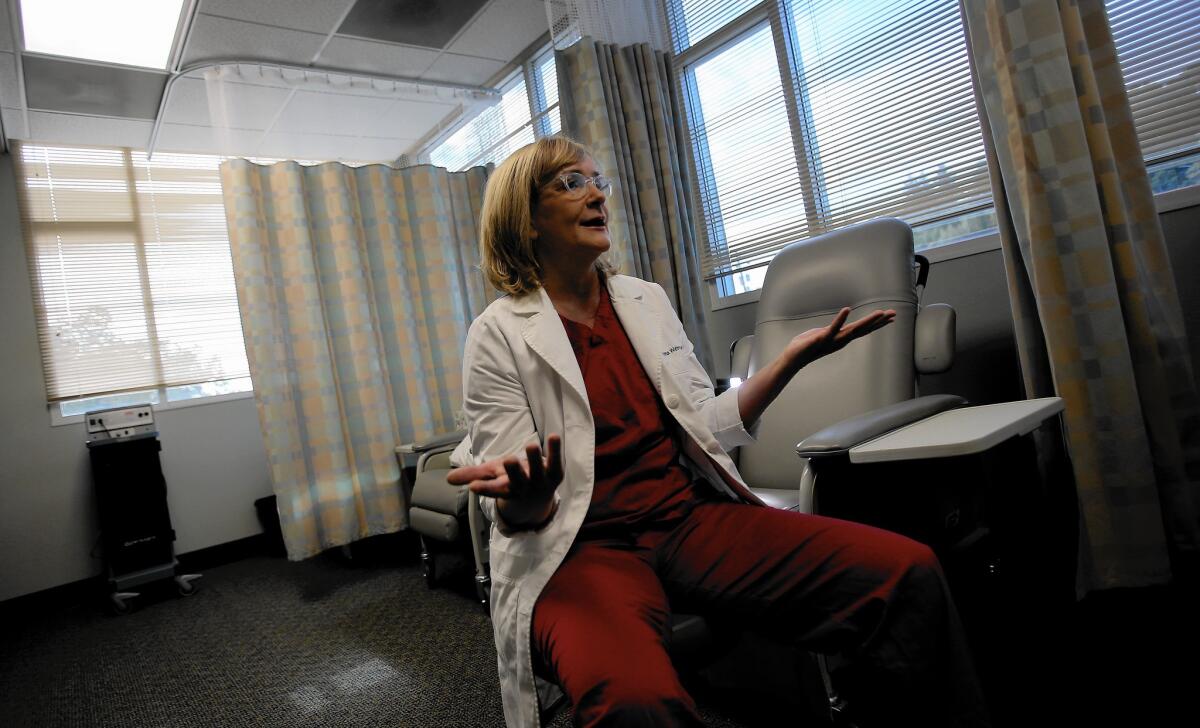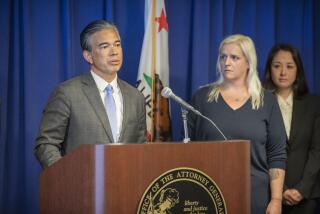The Abortion Wars: New class of abortion providers helps expand access in California

- Share via
reporting from SAN RAFAEL, Calif. — Ever since the Planned Parenthood health center here opened, the six cushioned recliners in the recovery room had been in steady demand every Friday.
That’s when a physician would rotate through to perform abortions for four hours. When everyone in the crowded waiting room knew why the woman next to her was there, when they all had to walk past a cluster of antiabortion protesters.
But a state law that went into effect in January has authorized nurse practitioners, certified nurse midwives and physician assistants to perform a method of first-trimester abortion known as vacuum aspiration. Previously, only doctors were allowed to do so.
With the expanded pool of providers, this Marin County clinic can now carry out the procedure as routinely as breast exams and birth control consultations, stripping away the taint of “abortion day.”
“It’s a much less stigmatizing way to offer an abortion,” said Anna, a nurse practitioner and certified nurse midwife who performs vacuum abortions at the clinic. She asked that her last name not be used because she feared for her safety.
Although state legislatures across the country have passed laws in record numbers over the last four years setting restrictions on abortions — undermining Roe vs. Wade, the 1973 Supreme Court decision that legalized abortion — California continues to move in the opposite direction.
Of all the abortion-related laws passed in the U.S. last year, California’s Assembly Bill 154 was the only one that increased the number of abortion providers.
Although four other states allow such clinicians to perform aspiration abortions, none other had to override a physician-only law.
The Assembly bill is only the third piece of abortion legislation passed in California since statehood. The law cements California’s reputation as “the gold standard” for access to abortion, said Vicki Saporta, president of the National Abortion Federation.
Four dozen practitioners were trained as part of a study that smoothed the way for the new law. Many are now putting their skills to use. They’ve made it possible for some clinics to expand availability of first-trimester abortion — when it is safest and least costly.
Since March, Anna, 53, has integrated vacuum abortions into daily care at this Planned Parenthood clinic, where she is lead clinician. Advocates say it appears to be first in the state and one of a handful in the country to move away from segregated abortion days.
These days, the bright recovery room generally hosts one woman at a time — an abortion patient who probably awaited her appointment, privacy intact, beside someone scheduled for a routine procedure.
Most abortions are conducted in the first trimester, by one of two methods. In medication abortion, a drug combination is administered under clinic guidance to a woman up to 10 weeks along. It essentially causes her to miscarry at home. In vacuum aspiration, conducted until the end of the first trimester, contents of the uterus are suctioned out.
Non-doctors who can offer aspiration abortions are known as advance practice clinicians. They have been able to administer medication abortions legally in California for a dozen years. But a law dating to the 1970s, passed to protect women from unscrupulous providers, prohibited anyone but a physician from performing abortions deemed “surgical.”
A six-year study conducted by a research arm of UC San Francisco’s Bixby Center for Global Reproductive Health persuaded the Legislature to change the law. It involved nearly 17,000 California women, more than 80% of whom chose to receive an aspiration abortion from an advance practice clinician under a doctor’s supervision.
The study’s conclusion? That the nonphysicians performed the procedure as safely as the doctors.
Only a few of the clinicians trained under the study are practicing in remote corners of California. Advocates of abortion rights hope that will change as new training programs target those living in, or willing to move to, the estimated half of California’s 58 counties with no readily available provider.
UCSF’s School of Nursing leads the effort to cultivate the new workforce. Before vacuum aspirations can be added to the curriculum in fall 2016, more practitioners in the field must learn how to be trainers. Before that can happen, faculty members must become adept.
The school’s first faculty clinician began hands-on training at San Francisco General Hospital last month. By next fall, she and others will help offer a post-masters certification program to other clinicians who can then train students at their facilities.
As a doula early in her career, Anna cared for women from early pregnancy through delivery — and in cases of miscarriage and abortion as well. Pregnancy is “not all about having babies,” she said, noting 1 in 5 pregnancies ends in miscarriage and about 1 in 3 women has had an abortion.
Anna began offering abortion medication as soon as she was legally able. When she learned UCSF was seeking trainees for the study on aspiration abortion, she immediately signed up.
Her model of including aspirations on the clinic’s daily schedule of services will not work everywhere, said Jeff Waldman, medical director of Planned Parenthood Northern California. It works at the San Rafael clinic because Anna’s skills are outstanding and the volume of procedures has declined, he said. That is true nationwide, as the number of unwanted pregnancies drop and more women who need early abortion select the medication alternative.
The California law and the study that made it possible were not without controversy.
Jeannette Dreisbach, a Palm Springs-based antiabortion watchdog, criticized the data and called the training prescribed in the law inadequate.
“We may be going from schlock physician abortionist,” she warned, “to schlock nonphysician abortionist.”
But Diana Taylor, the study’s principal investigator and co-director, called the research “beyond reproach.” It was vetted through quarterly data reports and visits from state-appointed evaluators, three research ethics boards, a clinical safety monitoring committee and a panel of outside experts.
Already, the change is playing out in other parts of the state.
Rose, who asked that only her middle name be used, is a nurse practitioner at the Planned Parenthood in Watsonville and was a trainee under the study.
For the last dozen years, she has provided services including medication abortion to a largely farmworker clientele. That process, which takes two days, is not a good option for women without a flexible work schedule or who lack privacy at home, so she has sent them to other towns, to physicians they had never met. The Watsonville clinic is not equipped to offer aspiration abortions.
These days, however, she follows the women through pregnancy tests, ultrasound and counseling, then often performs their aspiration abortions herself in Santa Cruz or Seaside.
“It helps to have a familiar face,” she said. “And on those rare occasions when I have some sort of finding I can let them know, ‘We’re going to take care of that when you come back to Watsonville. Let’s start a treatment plan.’”
And if others follow the Marin County clinic’s example, said Dr. Susan Robinson, one of the study’s trainers, the change in the law could help to normalize a procedure that has for decades been siloed.
The hope, she said, is that as the new workforce expands, advance practice clinicians “might have a diaspora to smaller underserved towns where they could have a greater scope of practice — and this would be included in it, just exactly how Anna does it.”
Twitter: @leeromney
Times staff writer Maria L. La Ganga contributed to this report.
More to Read
Sign up for Essential California
The most important California stories and recommendations in your inbox every morning.
You may occasionally receive promotional content from the Los Angeles Times.











